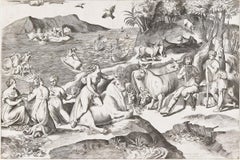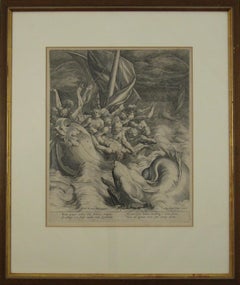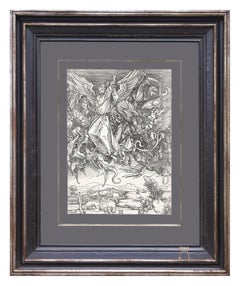16th Century Prints and Multiples
Italian School 16th Century Prints and Multiples
Engraving
Modern 16th Century Prints and Multiples
Etching
Renaissance 16th Century Prints and Multiples
Laid Paper, Engraving
Renaissance 16th Century Prints and Multiples
Laid Paper, Engraving
Expressionist 16th Century Prints and Multiples
Handmade Paper
16th Century Prints and Multiples
Engraving
Modern 16th Century Prints and Multiples
Etching
Modern 16th Century Prints and Multiples
Etching
Contemporary 16th Century Prints and Multiples
Etching
16th Century Prints and Multiples
Etching
Northern Renaissance 16th Century Prints and Multiples
Woodcut, Paper
Old Masters 16th Century Prints and Multiples
Engraving
Northern Renaissance 16th Century Prints and Multiples
Etching
Dutch School 16th Century Prints and Multiples
Ink, Laid Paper, Engraving
Old Masters 16th Century Prints and Multiples
Handmade Paper, Laid Paper, Engraving
Naturalistic 16th Century Prints and Multiples
Ink, Laid Paper, Engraving
Old Masters 16th Century Prints and Multiples
Engraving
Old Masters 16th Century Prints and Multiples
Engraving
Old Masters 16th Century Prints and Multiples
Engraving
Old Masters 16th Century Prints and Multiples
Archival Ink, Rag Paper
Old Masters 16th Century Prints and Multiples
Paper
Old Masters 16th Century Prints and Multiples
Archival Ink, Rag Paper
Old Masters 16th Century Prints and Multiples
Laid Paper, Woodcut
Old Masters 16th Century Prints and Multiples
Engraving
Old Masters 16th Century Prints and Multiples
Metal
Old Masters 16th Century Prints and Multiples
Engraving
Renaissance 16th Century Prints and Multiples
Woodcut
Old Masters 16th Century Prints and Multiples
Metal
Old Masters 16th Century Prints and Multiples
Engraving
Old Masters 16th Century Prints and Multiples
Archival Ink, Rag Paper
Old Masters 16th Century Prints and Multiples
Metal
Old Masters 16th Century Prints and Multiples
Metal
Renaissance 16th Century Prints and Multiples
Engraving
Realist 16th Century Prints and Multiples
Lithograph
Old Masters 16th Century Prints and Multiples
Laid Paper, Engraving, Intaglio
Renaissance 16th Century Prints and Multiples
Engraving
Old Masters 16th Century Prints and Multiples
Engraving
Old Masters 16th Century Prints and Multiples
Woodcut
Old Masters 16th Century Prints and Multiples
Laid Paper, Ink, Woodcut
Old Masters 16th Century Prints and Multiples
Engraving
Old Masters 16th Century Prints and Multiples
Laid Paper, Engraving
Old Masters 16th Century Prints and Multiples
Etching
Old Masters 16th Century Prints and Multiples
Engraving
Modern 16th Century Prints and Multiples
Woodcut
Old Masters 16th Century Prints and Multiples
Etching
Baroque 16th Century Prints and Multiples
Engraving
Old Masters 16th Century Prints and Multiples
Etching
Other Art Style 16th Century Prints and Multiples
Lithograph
Old Masters 16th Century Prints and Multiples
Etching
Other Art Style 16th Century Prints and Multiples
Engraving
Old Masters 16th Century Prints and Multiples
Engraving
16th Century Prints and Multiples
Lithograph
16th Century Prints and Multiples
Engraving
Modern 16th Century Prints and Multiples
Etching
Northern Renaissance 16th Century Prints and Multiples
Engraving
Old Masters 16th Century Prints and Multiples
Etching
16th Century Prints and Multiples
Etching
16th Century Prints and Multiples
Etching
Read More
Art Brings the Drama in These Intriguing 1stDibs 50 Spaces
The world’s top designers explain how they display art to elicit the natural (and supernatural) energy of home interiors.
Welcome (Back) to the Wild, Wonderful World of Walasse Ting
Americans are rediscovering the globe-trotting painter and poet, who was connected to all sorts of art movements across a long and varied career.
Shapero Modern’s Director Tells Us All about 20th-Century Prints
Tabitha Philpott-Kent knows a lot of art multiples. Here, the London gallery director talks about what makes printmaking so fabulous.
Yoshitomo Nara Puts a Punk Rock Twist on the Traditional Prints of His Ancestors
The forever-rebellious Japanese artist craftily defaces famous Edo Period woodblock prints with “In the Floating World.”
Red Grooms Salutes the ‘Ninth Street Women’ Who Revolutionized Modern Art
In a new show of peppy portraits, the 85-year-old artist looks back at 1950s New York, when the Abstract Expressionists ruled the scene. Only now, the women Ab-Ex artists get more of the spotlight than the men.
Just What Is an Intaglio Print, and What Makes It a Good Investment?
Bay Area art publisher Rhea Fontaine explains the difference between intaglio and woodcut printing, how to frame fine art prints and what makes them attractive to collectors.
Andy Warhol Piles Up the Gifts in This Fanciful Christmas Print
Created in the late 1950s, it’s one of a surprising number of holiday-themed works by the prolific Pop artist.
A Derrick Adams Double Portrait Brings Out the Interior Lives of His Subjects
Adams has skyrocketed to art superstardom with his exuberant depictions of Black life. Here's what makes his work important to our times.






